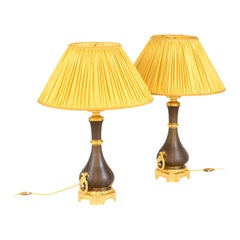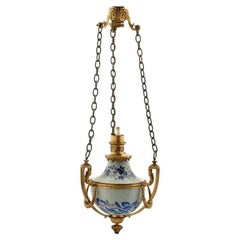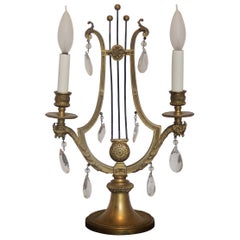Gagneau Frères Furniture
2
to
2
2
2
2
2
2
1
1
1
1
2
1
1
5,289
4,012
2,455
2,235
Creator: Gagneau Frères
Maison Gagneau, Pair of Louis XVI Style Lamps, circa 1880
By Gagneau Frères
Located in Saint-Ouen, FR
Maison Gagneau, signed.
Pair of baluster shape Louis XVI style lamps in guilloche brown brass.
Chiselled and gilt bronze mount. High of the mount with...
Category
1880s European Napoleon III Antique Gagneau Frères Furniture
Materials
Brass
Pair of Gilt Bronze Mounted Faience Lamps by Deck
By Theodore Deck, Gagneau Frères
Located in London, GB
These beautiful table lamps are by Théodore deck, one of the most important ceramicists of the 19th Century, and Gagneau Frères, a leading bronzier. Deck was the director of a presti...
Category
Late 19th Century French Antique Gagneau Frères Furniture
Materials
Ormolu, Bronze
Related Items
Pair of Romantic Yellow Tole Urns Mounted as Lamps
Located in Kittery Point, ME
Each mounted as a lamp, the flaring top above a stepped square base, with a decor of antique scenes and symbols. Electrified. Measures: Height of urns only, 15in.; height overall, 29...
Category
19th Century French Romantic Antique Gagneau Frères Furniture
Materials
Tôle
Pair of Neoclassical Patinated Bronze and Red Marble Urns Mounted as Lamps
Located in Kittery Point, ME
Each urn cast with frieze of classical figures, raised on a bronze-mounted rouge griotte square marble base. The lampshades are silk and custom made by Blanche Field...
Category
Late 19th Century French Neoclassical Antique Gagneau Frères Furniture
Materials
Griotte Marble, Bronze
Pair of 19th Century Gilt-Bronze & Faience Porcelain Table Lamp Candelabras
Located in Los Angeles, CA
A fine pair of French 19th-20th century Louis XV style gilt bronze and Faience porcelain three-light candelabra table lamps. The ovoid porcelain urn hand decorated in floral burgundy...
Category
Early 1900s French Louis XV Antique Gagneau Frères Furniture
Materials
Ormolu, Bronze
H 32 in W 12 in D 10.75 in
Théodore Deck (1823-1891), Miniature Pair of Faience Vases circa 1870
By Theodore Deck
Located in Saint-Ouen, FR
Theodore Deck (1823-1891)
A deep green enameled faience miniature pair of vases molded in the Chinese Archaistic Taste.
Coves in the shape of elepha...
Category
1870s French Chinoiserie Antique Gagneau Frères Furniture
Materials
Faience
Free Shipping
H 4.34 in W 2.96 in D 2.37 in
Pair of Table Lamps by Giulia Mangani Louis XVI-Style
By Giulia Mangani
Located in Casteren, Noord-Brabant
Two beautiful large lamps by the Italian brand Giulia Mangani. The lamps are made of metal, covered with faux Marble and gold-coloured ornaments. Inspired by a design from the French...
Category
Early 2000s Italian Louis XVI Gagneau Frères Furniture
Materials
Metal
Pair of Louis XVI style Gilt Bronze Bouillotte Lamps
Located in New York, NY
Pair of French 19 century gilt bronze French bouillotte Lamps with hand-painted metal shades, with wiring and sockets, ready for use.
The Candelabras are 19 century and converted to...
Category
1890s Louis XVI Antique Gagneau Frères Furniture
Materials
Bronze, Metal
Pair of French, 19th Century Neoclassical Style Gilt Bronze and Marble Urn Lamps
Located in Los Angeles, CA
A very fine pair of French, 19th century neoclassical style gilt bronze-mounted marble urns. The ovoid form marble urns flanked by foliate scroll handles with satyr mask terminals, o...
Category
Late 19th Century French Neoclassical Antique Gagneau Frères Furniture
Materials
Marble, Brass, Bronze
H 43.75 in W 13 in D 9.5 in
Theodore Deck '1823-1891', a Japonisme Polychromed Faience Quadrangular Vase
By Theodore Deck
Located in Saint-Ouen, FR
Theodore Deck (1823-1891)
A Polychromed Faience quadrangular vase, decorated in a cartouche with butterfly and birds on branches of prunus and peonies in the Japanese Taste on a pu...
Category
Late 19th Century French Japonisme Antique Gagneau Frères Furniture
Materials
Faience
H 18.9 in W 9.45 in D 8.67 in
Pair Louis XVI Style French Porcelain Table Lamp
Located in Tarry Town, NY
Early 20th century Louis XVI style French porcelain and hand gilt gold decorated urn shape vase pair table lamp. Each lamp features on one side a painted pastoral scenes decorated de...
Category
1920s French Louis XVI Vintage Gagneau Frères Furniture
Materials
Gold, Brass
Elegant Chinese Famille Rose Vase and Gilt Bronze Mount, Side Table Lamp antique
Located in West Hollywood, CA
Elegant Chinese Famille Rose Vase and Gilt Bronze Mount, Side Table Lamp antique . Very fine 19th century Chinese Famille rose Baluster vases with ...
Category
Late 19th Century Chinese Antique Gagneau Frères Furniture
Materials
Bronze
Pair French 19th Century Napoleon III Empire Style Gilt-Bronze Urn Table Lamps
By Pierre-Philippe Thomire
Located in Los Angeles, CA
A fine pair of French 19th century Napoleon III Empire style patinated-bronze and gilt-bronze mounted allegorical covered urn vases lamps in the manner of Pierre-Philippe Thomire (Fr...
Category
Late 19th Century French Empire Antique Gagneau Frères Furniture
Materials
Bronze
Pair of Porcelain Vases Ormolu-Mounted in Lamps by Gagneau Paris XIXth Century
By Gagneau Paris
Located in Saint-Ouen, FR
Pair of large Japanese Porcelain Cone Shape Vases with Imari decoration
Important mounts in ormolu and gilded metal, the base decorated with a laurel wreath, the upper part of falling leaves and a frieze of knotted ribbon.
The mounts signed Gagneau, 115 R. Lafayette.
Circa 1860
With their original aluminium bulb cover and original gilding
Vase it self Height 47 cm
The Gagneau Company is one of the most famous lighting factories in Paris in the nine-teenth century, established in 1800 at 25 rue d'Enghien in Paris and later at 115 rue de Lafayette. She has participated in many exhibitions throughout this century. She began in 1819 with the Exposition des Produits de l'Industrie and later participated in the Universal Exhibitions where she was part of the jury in the category of art bronzes (class 25) at the Universal Exhibition in Paris in 1889.
"Imari" was simply the trans-shipment port for Arita wares, from where they went to the for-eign trading outposts at Nagasaki. It was the kilns at Arita which formed the heart of the Japanese porcelain industry.
Arita's kilns were set up in the 17th century, after kaolin was discovered in 1616. A popular legend attributes the discovery to an immigrant Korean potter, Yi Sam-Pyeong (1579–1655), although most historians consider this doubtful. After the discovery, some kilns began to produce revised Korean-style blue and white porcelains, known as Early Imari, or "Shoki-Imari".
In the mid-17th century, there were also many Chinese refugees in northern Kyushu due to the turmoil in China, and it is said that one of them brought the overglaze enamel coloring technique to Arita. Thus Shoki-Imari developed into Ko-Kutani, Imari, and later Kakiemon, which are sometimes taken as a wider group of Imari wares. Ko-Kutani was produced around 1650 for both export and domestic market.Kutani Ware is characterized by vivid green, blue, purple, yellow and red colors in bold designs of landscapes and nature. Blue and white porcelain pieces continued to be produced and they are called Ai-Kutani. Ko-Kutani Imari for the export market usually adopted Chinese design structure such as kraak style, whereas Ai-Kutani for the domestic market were highly unique in design and are ac-cordingly valued very much among collectors.
Ko-Kutani style evolved into Kakiemon-style Imari, which was produced for about 50 years around 1700. Kakiemon was characterized by crisp lines, and bright blue, red and green designs of dramatically stylized floral and bird scenes. Imari achieved its technical and aes-thetic peak in the Kakiemon style, and it dominated the European market. Blue and white Kakiemon is called Ai-Kakiemon. The Kakiemon style transformed into Kinrande in the 18th century, using underglaze blue and overglaze red and gold enamels, and later additional colors.
Imari began to be exported to Europe when the Chinese kilns at Jingdezhen were damaged in the political chaos and the new Qing dynasty government halted trade in 1656–1684. Ex-ports to Europe were made through the Dutch East India Company, and in Europe the des-ignation "Imari porcelain" connotes Arita wares of mostly Kinrande Imari.
Export of Imari to Europe stopped in mid-18th century when China resumed export to Europe, since Imari was not able to compete against Chinese products due to high labor costs. By that time, however, both Imari and Kakiemon styles were already so popular among Eu-ropeans that the Chinese export porcelain copied both, a type known as Chinese Imari. At the same time, European kilns, such as Meissen and English potteries such as Johnson Bros. and (Royal) Crown Derby, also imitated the Imari and Kakiemon styles.
Export of Imari surged again in late 19th century (Meiji era) when Japonism flourished in Europe.Thus, in the western world today, two kinds of true Japanese Imari can...
Category
1880s French Japonisme Antique Gagneau Frères Furniture
Materials
Bronze
H 38.59 in Dm 10.24 in
Previously Available Items
Antique French Gilt Bronze Porcelain Chandelier
By Gagneau Frères
Located in New York, NY
An antique late 19th-century French gilt bronze chandelier with modern electrical fittings. Crackle porcelain centerpiece with hand-painted flowers is hung on three chains. The bronz...
Category
19th Century French Antique Gagneau Frères Furniture
Materials
Bronze
19th Century Gilt Bronze and Crystal Two Light Candelabra by Gagneau Frères
By Gagneau Frères
Located in New York, NY
An interesting late 19th century gilt bronze and drop crystal two light candelabra lamp
By Gagneau Frères
Shaped as a lyre with tear...
Category
Late 19th Century French Belle Époque Antique Gagneau Frères Furniture
Materials
Crystal, Bronze
Gagneau Frères furniture for sale on 1stDibs.
Gagneau Frères furniture are available for sale on 1stDibs. These distinctive items are frequently made of metal and are designed with extraordinary care. There are many options to choose from in our collection of Gagneau Frères furniture, although orange editions of this piece are particularly popular. If you’re looking for additional options, many customers also consider furniture by Charles Valton, Jules Moigniez, and Porcelaine de Paris. Prices for Gagneau Frères furniture can differ depending upon size, time period and other attributes — on 1stDibs, these items begin at $5,175 and can go as high as $15,090, while a piece like these, on average, fetch $10,133.





